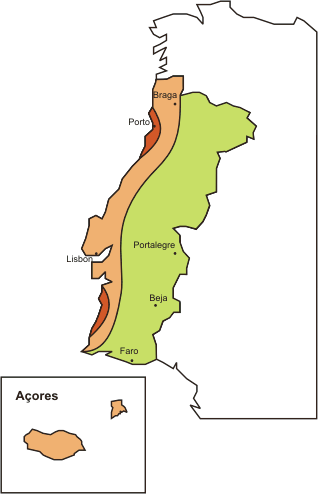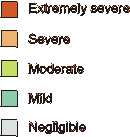
 |
The following map was adapted from a series of corrosivity maps for Zn, Fe, Cu and Al published in a document edited by M.E. Almeida and M.G.S. Ferreira (1998). The help of Dr. Joao C. Salvador Fernandes (Lisbon) for obtaining these documents is greatly acknowledged.


Following its heyday as a world power during the 15th and 16th centuries, Portugal lost much of its wealth and status with the destruction of Lisbon in a 1755 earthquake, occupation during the Napoleonic Wars, and the loss of its Brazilian colony in 1822. A 1910 revolution deposed the monarchy. For most of the next six decades repressive governments ran the country. In 1974, a left-wing military coup installed broad democratic reforms. The following year Portugal granted independence to all of its African colonies. Portugal entered the European Community in 1985.
At the moment there are 84 AQ monitoring stations in Portugal which belongs to the following networks:
Privatenetworksassociated to large industrial plants. There are 6 networks and the responsible for the measurements are the industries themselves.
Localnetworks,which are 5, associated to urban and/or industrial areas. These networks are managed by Local Commissions for Air Management (CGAs) which are integrated in the Regional Directorates for Environment and Natural Resources (CGA-Porto in the North Regional Directorate, CGA-Estarreja in Center Regional Directorate, CGA-Lisboa and CGA-Barreiro/Seixal in Lisboa e Vale do Tejo Regional Directorate and CGA-Sines in Alentejo Regional Directorate).
Nationalnetwork,with 15 stations, have been operated since 1986. Some of these stations also belong to the Local Networks. The national institution responsible for this network is the Meteorological Institute (IM).
EMEPnetworkwith 5 stations.
BAPMoNnetworkwith 8 stations.
The coverage is substantial. The existing stations cover the main urban areas (cities of Lisboa, Porto, Coimbra, Setúbal and Faro), the industrial or urban/industrial areas (Barreiro/Seixal, Sines and Estarreja) and the areas within the influence of large plants. However, it is still necessary to have more stations in some of these areas, principally in urban sites to obtain a better coverage. There are also some other places which are not yet covered. For these areas there have been made some campaigns for data collection with a mobile station.
Other regions and countries: Argentina, Brazil, Canada, Central America, Chile, China, Colombia, Cuba, France, Germany, India, Italy, Japan, Mexico, New Zealand, North America, Portugal, Russia, Saudi Arabia, South Africa, Spain, Sweden, UK, USA, Venezuela
 |
 |